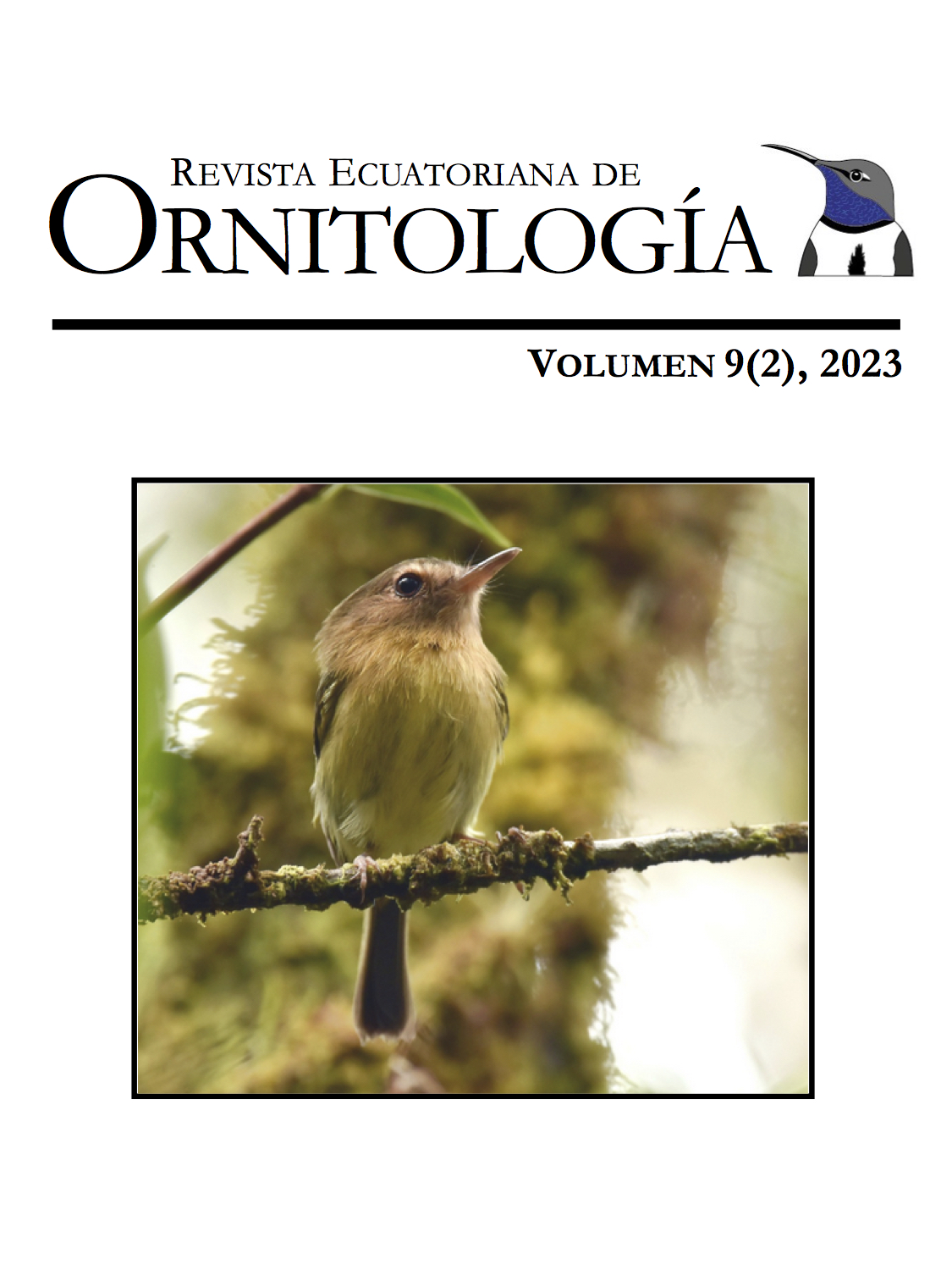FIRST NEST DESCRIPTION OF Sapayoa aenigma (SAPAYOIDAE) IN ECUADOR
DOI:
https://doi.org/10.18272/reo.v9i2.2791Keywords:
Breeding biology, Chocó, nest, nestlingsAbstract
Sapayoa Sapayoa aenigma is endemic to the Chocó rainforests from Panama to northern Ecuador. There are few behavioural observations throughout its range; therefore, we describe a nest studied between April and May 2022 in Canandé, Esmeraldas. The nest was closed-long and pensile, and was placed 2.3 m above the water in a branch of a 3-m tall bush of the genus Henriettea (Melastomataceae). It was placed next to a permanent stream in a ravine c. 2 m deep. Habitat was mature forest on both ravine slopes, dominated by tall trees, open understory, with a diameter at breast height of less than 30 cm. The nest contained two nestlings that had closed eyes. This is the fourth active nest of S. aenigma reported and the first for Ecuador.
Downloads
References
Cadena-Ortiz, H. F. (2018). Sugerencias para la toma de datos en eventos de biología reproductiva de aves. ACI Avances en Ciencias e Ingenierías, 10(1), 24–35. DOI: https://doi.org/10.18272/aci.v10i1.297
Checa, M. F., Donoso, D. A., Rodríguez, J., Levy, E., Warren, A., & Willmott, K. (2019). Combining sampling techniques aids monitoring of tropical butterflies. Insect Conservation and Diversity, 12(4), 362–372. DOI: https://doi.org/10.1111/icad.12328
Christian, D. G. (2001). Nests and nesting behavior of some little-known Panamanian birds. Ornitologia Neotropical, 12(4), 327–336. URL: https://sora.unm.edu/node/119430
Durães, R., Carrasco, L., Smith, T. B., & Karubian, J. (2013). Effects of forest disturbance and habitat loss on avian communities in a Neotropical biodiversity hotspot. Biological Conservation, 166, 203–211. DOI: https://doi.org/10.1016/j.biocon.2013.07.007
Dzielski, S. A., Van Doren, B. M., Hruska, J. P., & Hite, J. M. (2016). Reproductive biology of the Sapayoa (Sapayoa aenigma), the “Old World suboscine” of the New World. The Auk, 133(3), 347–363. DOI: https://doi.org/10.1642/AUK-16-5.1
Menezes, J. C., & Marini, M. Â. (2017). Predators of bird nests in the Neotropics: a review. Journal of Field Ornithology, 88(2), 99-114. DOI: https://doi.org/10.1111/jofo.12203
Myers, N., Mittermeier, R. A., Mittermeier, C. G., da Fonseca, G. A. B., & Kent, J. (2000) Biodiversity hotspots for conservation priorities. Nature, 403, 853–858. DOI: https://doi.org/10.1038/35002501
Remsen, J. V., Jr., Areta, J. I., Bonaccorso, E., Claramunt, S., Jaramillo, A., Lane, D. F., Pacheco, J. F., Robbins, M. B., Stiles, F. G., & Zimmer, K. J. (2022, Mayo 26). A classification of the bird species of South America. American Ornithological Society. Versión 26 Mayo 2022. URL: http://www.museum.lsu.edu/~Remsen/SACCBaseline.htm
Simon, J. E., & Pacheco, S. (2005). On the standardization of nest descriptions of neotropical birds. Revista Brasileira de Ornitologia, 13(2), 143-154. URL: http://revbrasilornitol.com.br/BJO/article/view/2201/pdf_329
Snow, D. (2022, Mayo 26). Sapayoa (Sapayoa aenigma). Version 1.0. En J. del Hoyo, A. Elliott, J. Sargatal, D. A. Christie & E. de Juana (Eds), Birds of the World. Ithaca, NY: Cornell Lab of Ornithology. DOI: https://doi.org/10.2173/bow.sapayo1.01
Tamayo, F., Torres, B., Fischer, R., Lajones, A., Cervantes, R., Corozo, C., Velasco, R. F., & Günter, S. (2020). Caracterización de paisajes forestales en el Noroccidente ecuatoriano: deforestación y aspectos socioculturales. En B. Torres, R. Fischer, J.C. Vargas, & S. Günter (Eds), Deforestación en paisajes forestales tropicales del Ecuador: bases científicas para perspectivas políticas (pp. 70–92). Puyo, Ecuador: Universidad Estatal Amazónica & Instituto Johann Heinrich von Thünen. URL: http://inabio.biodiversidad.gob.ec/wp-content/uploads/2021/01/LAFORET_WEB.pdf
Van Doren, B. M., Hruska, J. P., Dzielski, S. A., & Butcher, B. G. (2019). Helpers at a Sapayoa nest are kin. Bulletin of the British Ornithologists’ Club, 139(2), 94–98. DOI: https://doi.org/10.25226/bboc.v139i2.2019.a1
Downloads
Published
How to Cite
Issue
Section
License
Copyright (c) 2023 Héctor Cadena-Ortiz, Francesca Angiolani

This work is licensed under a Creative Commons Attribution-NonCommercial 4.0 International License.
Los autores que publiquen en la Revista Ecuatoriana de Ornitología aceptan los siguientes términos:
- Los autores/as conservarán sus derechos de autor y garantizarán a la revista el derecho de primera publicación de su obra, el cuál estará simultáneamente sujeto a la Licencia de Reconocimiento No Comercial de Creative Commons.
- Los autores/as podrán adoptar otros acuerdos de licencia no exclusiva de distribución de la versión de la obra publicada, pudiendo de esa forma publicarla en un volumen monográfico o reproducirla de otras formas, siempre que se indique la publicación inicial en esta revista.
- Se permite y se recomienda a los autores difundir su obra a través de Internet en su repositorio institucional, página web personal, o red social científica (como ResearchGate o Academia.edu).


